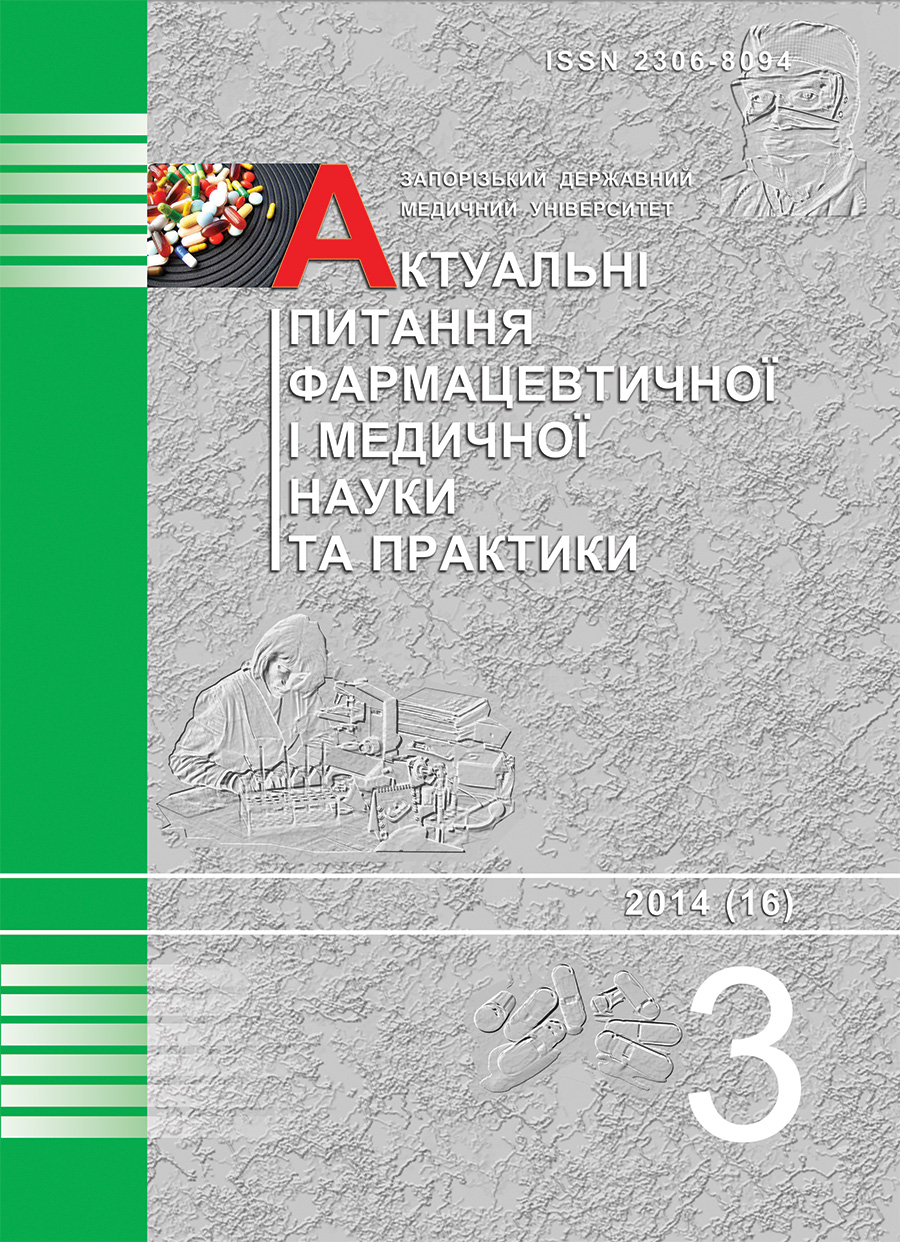Synthesis, chemical and biological properties of the new mono- and bis-derivatives of imidazoles
DOI:
https://doi.org/10.14739/2409-2932.2014.3.32434Keywords:
imidazole, halothane, antitumour activity, lectinAbstract
The aim of research. The problem of finding effective antitumour medical preparation with low toxicity is an important issue of medical and pharmaceutical chemistry. Knowledge of cancer cell features and its metabolism enables to predict the direction of chemical and biological research, to conduct a targeted synthesis of potential drugs, and to assess their applicability in oncological practice as antitumor agents. The purpose of work is to explain preformed heterocycles as purines, its synthesis and investigation of chemical and biological properties. After construction of the potential active structures we proposed the new method of original derivatives synthesis which are received on the base of imidazole, from one side, and fluorocontaining common anesthetic halothane (2-bromo-1,1,1-trifluoro-2-chloroethane) from other side. Molecular complex of more perspective biologically active bis-imidazole with antitumour bacterial lectine has been received. With the purpose to synthesize potential antitumour compounds on the base of halothane and imidazole, new convenient methods for the preparation of original heterocyclic derivatives of imidazole have been described. The structure and composition of synthesized compound has been confirmed by the methods of elemental analysis, IR- and NMRІН-spectra.
Materials and methods. The majority of the absolute organic solvents (benzene, dimethylformamide, ethyl ester) employed in the present studies were distilled before their use. Organic solvents were dried over anhydrous magnesium sulfate or metallic sodium. Gas-liquid chromatography was carried out by Perkin Elmer chromatograph with UV-detector ("Perkin", Germany). IR spectra were recorded in a UR-20 spectrometer ("Charles Ceise Hena", Germany). The 1HNMR spectra were recorded in DMSO-d6 on a 200 MHz BrakerWP-200 ("Braker", Switzerland) or Varian T-60 spectrometer ("Varian", USA). Investigation of critical toxicity of new compounds was carried out at Institute of Pharmacology and Toxicology of National Academy of Medical Sciences of Ukraine. The lectin’s preparations were obtained by treatment of culture Liquid of saprophytic strain Bacillus from Ukrainian Collection of Microorganisms of Institute of Microbiology and Virology (IMV): B. polymyxa 102 KGU; in future: lectine 102) was clarified by treatment with ammonium sulfate (70% concentration of a saturated solution).
Results. For the first time the interaction of a series of imidazole substituted with halothane compounds have been investigated, the conditions of the reaction have been defined, the methods have been developed and the composition of the reaction products has been studied. The studies revealed that the initial heterocycle, namely imidazole reacts with the intermediate product of halothane conversion in an alkaline medium, under conditions of phase transfer catalysis DB-18-crown-6 in a solvent system (dimethyl formamide - benzene - diethyl ether) or in another variant: in DMSO with the presence of anhydrous potassium carbonate with the formation of mono-and bis-derivatives of imidazole. This reaction made possible a new strategy of synthesis of selectively poly-functionalized molecules, the chemical structure of which is available for incorporation of new pharmacophore fragments into molecule. It has been discovered that mono-, bis-derivatives of imidazole, molecular complex of bis-derivative of imidazole and antitumour bacterial lectin are low toxic preparations (LD50: from 278 mg/kg to 102 mg/kg).
Conclusion. New mono- and bis-adducts of imidazole, molecular complex of Bacillus polymyxa 102 KGU and imidazole bis-derivative have been prepared and its toxicity has been tested. New convenient methods for the preparation of heterocyclic mono- and bis-adducts of imidazole with 1,1,1-trifluoro-2-bromo-2-chloroethane (halothane) have been described. The reactions were catalyzed by DB-18-crown-6-complex (at the alkali medium). Investigation of the critical toxicity of compounds which have been synthesized shows that it has low toxicity: LD50 from 278 mg/kg up to 102 mg/kg. These fasts confirm that new derivatives of imidazole and molecular complex with antitumour bacterial lectin are perspective for the future investigation as substances with potential antitumour activity and low toxicity. The construction of the new medical preparations on the basis of the saprophytic strains bacterial lectines and heterocyclic bis-adducts is a very perspective direction.
References
Mashkovskij, M. D. (2006). Lekarstvennye sredstva [Medical preparations]. Мoscow: Novaya volna. [in Russian].
Baltina, L. A., Murinov, Y. I. & Ismagilova, A. F. (2001). Poluchenie i protivoopukholevaya aktivnost` kompleksnykh soedineniy β-glitsirrizinovoj kisloty s nekotorymi protivoopukholevimi preparatami [Obtaining and antitumour activity of the complex compounds of β-glycirrizinic acid with some of the antitumour drugs]. Khimiko-farmacevticheskij zhurnal, 35(11), 3–4. [in Russian].
Kleckij, M. E., Tsupak, E. B. & Nazarov, D. A. (2002). Struktura i reakcionnaya sposobnost` proizvodnykh uratcila [Structure and reactive ability of derivatives of uracile]. Khimiya geterociklicheskikh soedinenij, 8, 1106–1108. [in Latvia].
Orjales, A., Mosquera, R., Labeage, L., & Rodes, R. (1997). New 2-piperazinylbenzimidazole derivatives as 5-HT3 antagonists. Synthesis and pharmacological evaluation. Journal of Medical Chemistry, 40(4), 586–593. doi: 10.1021/jm960442e.
Isikava, N. (1990) Soedinenija ftora. Sintez i primenenie [Fluorine compounds. Synthesis and Application]. Moscow: Mir. [in Russian].
Yurchenko, A. A., Gur`eva, A. N., & Zarudnickij, E. V. (2009). Reakcii elektrofil`nogo zameshcheniya 1-metil-2-dimetilaminoimidazola [Reactions of electrophilic substitutions of 1-меthyl-2-dimethylaminoimidazole]. Zhurnal orhanichnoi ta farmatsevtychnoi khimii, 7, 1(25), 33–41. [in Ukrainian].
Gerus, I. I., Yagupolskij, Yu. L., Kolycheva, M. T. & Kukhar`, V. P. (1989). 1-Alkoksy(ariloksy)-1,1-diftor-2-chlor-2-brometany [1-Alkoxy(aryloxy)-1,1-difluoro-2-chloro-2-bromoetha-nes]. Zhurnal organicheskoj khimii, 25, 2020–2021. [in Russian].
Welchinska, H.V., Piecuszak, B., Kovalenko, E.A., & Sharykina, N.I. (2003). Biologicheskaya aktivnost bakterialnikh lektinov I ikh molekularnikh kompleksov s geterotsiklichnimy bis-adduktamy [Biological activity of bacterial lectins and their molecular complexes with heterocyclic bis-adducts]. Microbiological journal, 65(6), 20-25. [in Ukrainian].
Prozorovskij, V. B., Prozorovskij, V. P. & Demchenko, V. М. (1978). Ekspress-metod opredeleniya sredney e`ffektivnosti dozy i ego oshibka [Express-method of middle effective dose determination and its mistake]. Pharmacologiya i toksikologiya, 41 (4), 407–509. [in Russian].
Brody, G. L., & Sweet, R. B. (1963). Halothane anesthesia as a possible cause of massive hepatic necrosis. Anesthesiology, 24, 29–37.
Downloads
How to Cite
Issue
Section
License
Authors who publish with this journal retain copyright and grant the journal right of first publication with the work simultaneously licensed under a Creative Commons Attribution License that allows others to share the work with an acknowledgement of the work's authorship and initial publication in this journal.


